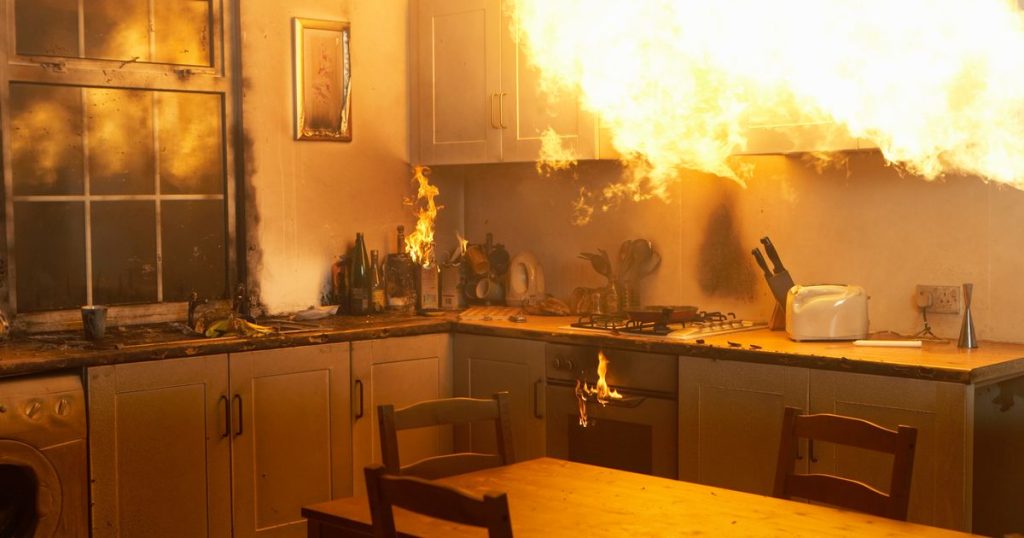The Danger of Grease Fires: An Introduction
Grease fires are one of the most terrifying kitchen mishaps, and they can happen to anyone, regardless of how experienced or careful you are. I know this firsthand. Years ago, I faced a grease fire in my apartment kitchen, and the memory still makes me nervous whenever I cook with oil. While the incident was terrifying, it taught me the importance of fire safety in the kitchen.
According to the National Fire Protection Association (NFPA), cooking is the leading cause of reported home fires and injuries in the U.S. Between 2017 and 2021, cooking accounted for about 44% of all reported home fires. These numbers are staggering, and they serve as a stark reminder that fire safety education is crucial for everyone. Chefs and fire safety experts emphasize that while we may think, “This won’t happen to me,” the reality is that grease fires can occur when we least expect them. Understanding how they start, how to prevent them, and how to put them out safely can be lifesaving.
Understanding Grease Fires: Causes and Warning Signs
Grease fires often start when oil or grease reaches its flash point, which is the temperature at which it ignites. Shawn Matijevich, a chef-instructor at the Institute of Culinary Education, explains that every oil has a unique smoke point (when it starts to smoke) and a flash point (when it catches fire). The flash point is typically about 50 degrees higher than the smoke point, meaning that once oil starts smoking, it can quickly escalate into a fire.
Jessica Randhawa, a food blogger who has experienced a grease fire, advises people to watch for smoke, not just flames. “The oil first begins to smoke before catching fire,” she says. This early warning sign is critical because it gives you a chance to address the issue before it spirals out of control. Knowing the smoke point of the oil you’re using is also important. For example, canola oil has a smoke point of 435 degrees Fahrenheit, while olive, corn, and sunflower oils have a smoke point of around 410 degrees. Checking a reliable chart, such as the one provided by the U.S. Department of Agriculture, can help you stay informed.
Preventing Grease Fires: Best Practices
Preventing a grease fire starts with paying attention to your cooking. According to the American Red Cross, the number one cause of cooking-related home fires is leaving the stove unattended. If you’re frying, boiling, or simmering, constant vigilance is essential. Stir the food regularly, and if the oil starts to smoke, reduce the heat immediately.
Distractions can quickly lead to disaster. For example, using your phone while cooking or leaving the kitchen while frying can result in flames erupting within just four to five minutes. Other risks include deep frying, which involves submerging food in hot oil that can easily overheat if not monitored. Being under the influence of alcohol or medications that impair judgment can also increase the likelihood of a grease fire.
To mitigate these risks, choose a pan that is at least twice the volume of the oil you’re using to prevent splattering. Cooking in batches if necessary and using a thermometer to monitor the oil’s temperature can also help. A candy/jelly/deep fry thermometer is the most reliable tool for this purpose. By staying proactive and attentive, you can significantly reduce the risk of a grease fire occurring in the first place.
How to Safely Extinguish a Grease Fire
If a grease fire does break out, staying calm and acting quickly is key. For small fires, smothering the flames by cutting off their oxygen supply is the safest approach. Use a metal lid, dry towel, or baking sheet to cover the pan or area on fire. However, this method is only effective for small fires, and you must ensure the lid or cover stays in place even after the flames appear to be gone, as the fire could reflash if exposed to oxygen again.
Water is not an option for extinguishing grease fires. It can cause the oil to splash and spread the fire further, leading to severe burns. Similarly, a wet towel or other substances like flour, sugar, or baking powder can worsen the situation. Baking soda, on the other hand, is safe to use for small grease fires, especially if the flames have spread beyond the cooking vessel. A helpful trick to remember is that baking soda is safe, while baking powder, which contains combustible elements, is not.
For larger fires, a Class B dry chemical fire extinguisher or a multipurpose fire extinguisher is your best bet. However, water-based extinguishers can make the situation worse, so ensure you have the right type handy. If the fire continues to grow despite these efforts, turn off the heat source immediately and evacuate the area. Call 911 or alert your local fire department without delay. Your safety is the top priority, and no meal is worth risking your life.
Dangerous Myths to Avoid
When it comes to grease fires, some so-called “hacks” can actually make the situation worse. Throwing water on the fire is a common mistake, but it can splatter the oil and spread the flames further. Similarly, using a wet towel can cause steam explosions, and substances like flour or baking powder can exacerbate the fire. These myths are dangerous and should be avoided at all costs.
Another mistake is picking up the pan or skillet and trying to move it, as this can cause the fire to spread. Instead, focus on cutting off the oxygen supply or using a fire extinguisher. Remember, every second counts, and making the wrong move can turn a small fire into a disaster.
Conclusion: Staying Safe in the Kitchen
Grease fires are a real and present danger in the kitchen, but with the right knowledge and precautions, they can be prevented and safely extinguished if they do occur. By understanding the risks, staying attentive while cooking, and knowing how to respond in an emergency, you can protect yourself, your loved ones, and your home from the devastation of a cooking fire.
Fire safety is not just about avoiding accidents; it’s about being prepared and taking proactive steps to ensure your kitchen is a safe space. From monitoring oil temperatures to keeping the right tools on hand, every small step you take can make a big difference. And if the worst happens, remember to stay calm, act quickly, and prioritize your safety above all else. After all, dinner can wait—your life is what truly matters.















